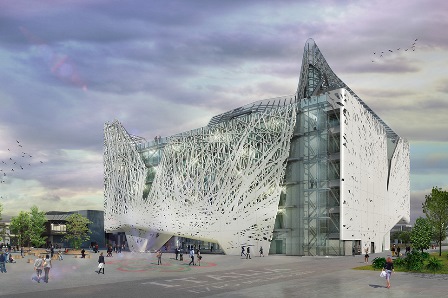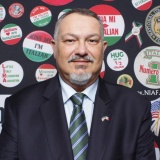
WTI Magazine #58 2015 April, 17
Author : Expo 2015 Translation by:
The Italian Pavilion will concentrate on exposing the national food culture and tradition in terms of very high quality products and finished goods. Italy's presence can be seen both inside the exposition areas, along the Cardo and at Palazzo Italia, the representative building where Italian State and Government representatives will be based.
Palazzo Italia will also be the location for official meetings between Italy and other participant countries. The areas reserved for European institutions, opposite Palazzo Italia and closely connected to the Cardo symbolically highlight the close relationship between Italy and the European Union.
Palazzo Italia represents the emblematic heart of the entire pavilion. It is destinedto be the center of technological innovation for the city after the Expo.
The design, created by Studio Nemesi & Partners Srl, Proger SpA and BMS Progetti Srl, was inspired by the surrounding nature and architecture:
- Emotional: visually evocative itineraries, richly vibrant and radiant, leading to the Palazzo Italia as the representation of a tree or a forest;
- Sustainable: essential and light like an example of "Land Art", Palazzo Italia is a spectacular and energy-efficient building;
- Technological: the building interacts and exchanges energy with itssurroundings through new technologies.
The main central square is divided into four functional blocks: the exhibition area, the events area, the offices area and the institutional area. Overhead is a scenic terrace which offers visitors a spectacular view across the site.
Along the Cardo
Within the site, the structure where the exhibition sites are located is akin to the typical structure of an Italian village. The various exhibition sites act as symbols of the varieties and differences that characterize Italy. The north represents the Italian territories and regions and the south, where Made in Italy is represented by excellent local food and sustainable products.
VIRTUAL TOUR: EXPLORE IN 3D PALAZZO ITALIA
Future Food District
Future Food District (#FFD) presents possible scenarios for the application of new technologies at each step of the food chain. It is a micro universe in which the visitor is invited to explore different interactions between people and food. The project is managed by Carlo Ratti, Director of the SENSEable City Lab at the Massachusetts Institute of Technology, together with Carlo Ratti Associates design studio. The #FFD is located on the south side of the Expo site where there is also the Open Air Theater and the walkway which connects with Cascina Merlata.
Future Food District according to Carlo Ratti
What story does it tell?
Future Food District is a micro universe that explores new ways for people and food to interact. This interaction is possible thanks to the use of new technologies and by applying the Internet of Things concept. Inside, we reflect on how food is and will be produced, distributed, prepared and consumed in the future. Through a solid information network we will be able to interact more with products and producers in order to develop a greater awareness of what we consume.
Can you give us three reasons to visit?
The first reason to visit this part of the exhibition is actually the space itself where technologies and natural elements co-exist, making the visit here an engaging and surprising experience. Another reason is to try a unique and interactive supermarket experience where everyone can be a producer and consumer at the same time. Finally, the third reason is to experiment with the use of smart technologies in the Kitchen with the help of professional chefs.
What is your vision of the future?
In the Future Food District man is at the center of a food chain that is more autonomous and sustainable thanks to the use of new technologies. As a result, the interaction between consumers and products goes back to being transparent and honest thanks to the sharing of information.
Where does your inspiration come from?
Paradoxically, the inspiration for this project comes from the past, when the place where one exchanged goods was where relationships were formed. The production and distribution chain was clearer and consumers knew more about the food they were eating. Through new technologies we become connected once again to the real world, eliminating barriers between consumers and producers in order to have a more direct relationship with food.
How did you interpret the theme?
The central theme Feeding the Planet, Energy for Life is interpreted here through the principles of awareness and interaction made possible thanks to the use of new technologies. These allow us to obtain information and directly interact with products and producers by using these technologies. We are given a real network that interacts with all things in the world, allowing us to understand each step of the food chain.
In what way do you communicate with visitors?
The Future Food District pavilions are highly interactive. Inside the supermarket it is possible to enjoy a shopping experience via flat screens, displays and interactive tables. In the kitchen pavilion it is possible to experiment with new ways of preparing food and the main square that connects the two pavilions is an ideal place for interacting and exchanging ideas with others.



